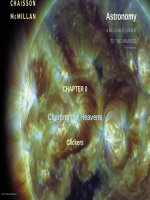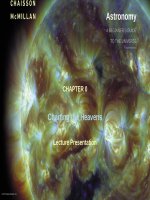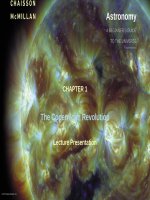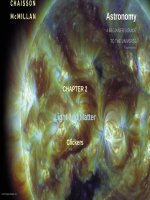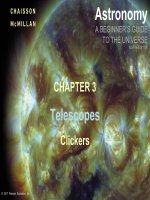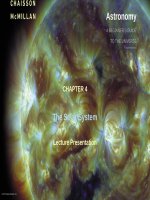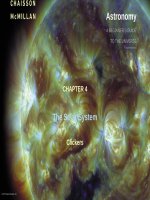Astronomy a beginners guide to the universe 8th CHaisson mcmillan chapter 02 clicker questions
Bạn đang xem bản rút gọn của tài liệu. Xem và tải ngay bản đầy đủ của tài liệu tại đây (993.48 KB, 19 trang )
Astronomy
A BEGINNER’S GUIDE
TO THE UNIVERSE
EIGHTH EDITION
CHAPTER 2
Light and Matter
Clickers
© 2017 Pearson Education, Inc.
Question 1
Which of these is NOT a form of electromagnetic radiation?
a)
b)
c)
d)
e)
© 2017 Pearson Education, Inc.
Gamma rays
Infrared
Sound
Visible light
Radio
Question 1
Which of these is NOT a form of electromagnetic radiation?
a)
b)
c)
d)
e)
Gamma rays
Infrared
Sound
Visible light
Radio
Explanation: Sound comes
from pressure waves; all
others are types of electromagnetic radiation of different wavelengths.
© 2017 Pearson Education, Inc.
Question 2
The distance between successive wave crests defines the _____ of a wave.
a)
b)
c)
d)
e)
© 2017 Pearson Education, Inc.
wavelength
frequency
period
amplitude
energy
Question 2
The distance between successive wave crests defines the _____ of a wave.
a)
b)
c)
d)
e)
wavelength
frequency
period
amplitude
energy
Explanation: Light can range from short-wavelength gamma rays to long-wavelength radio waves.
© 2017 Pearson Education, Inc.
Question 3
The frequency at which a star’s intensity is greatest depends directly on its
a)
b)
c)
d)
e)
© 2017 Pearson Education, Inc.
radius.
mass.
magnetic field.
temperature.
direction of motion.
Question 3
The frequency at which a star’s intensity is greatest depends directly on its
a)
b)
c)
d)
e)
radius.
mass.
magnetic field.
temperature.
direction of motion.
Explanation: Wien’s law means that
hotter stars produce much more
high-frequency light.
© 2017 Pearson Education, Inc.
Question 4
Rigel appears as a bright bluish star, whereas Betelgeuse appears as a bright reddish star.
Rigel is _____ Betelgeuse.
a)
b)
c)
d)
e)
cooler than
the same temperature as
Betelgeuse
older than
hotter than
The constellation ORION
more massive than
Rigel
© 2017 Pearson Education, Inc.
Question 4
Rigel appears as a bright bluish star, whereas Betelgeuse appears as a bright reddish star.
Rigel is _____ Betelgeuse.
a)
b)
c)
d)
e)
cooler than
the same temperature as
Betelgeuse
older than
hotter than
The constellation ORION
more massive than
Rigel
Explanation: Hotter stars look
bluer in color; cooler stars look redder.
© 2017 Pearson Education, Inc.
Question 5
If a light source is approaching you, you will observe that
a)
b)
c)
d)
e)
© 2017 Pearson Education, Inc.
its spectral lines are redshifted.
the light is much brighter.
its spectral lines are shorter in wavelength.
the amplitude of its waves has increased.
its photons have increased in speed.
Question 5
If a light source is approaching you, you will observe that
a)
b)
c)
d)
e)
its spectral lines are redshifted.
the light is much brighter.
its spectral lines are shorter in wavelength.
the amplitude of its waves has increased.
its photons have increased in speed.
Explanation: The Doppler shift explains that wavelengths from sources approaching us are blueshifted.
© 2017 Pearson Education, Inc.
Question 6
The wavelengths of emission lines produced by an element
a)
b)
c)
d)
e)
© 2017 Pearson Education, Inc.
depend on its temperature.
are identical to its absorption lines.
depend on its density.
are different from its absorption lines.
depend on its intensity.
Question 6
The wavelengths of emission lines produced by an element
a)
b)
c)
d)
e)
depend on its temperature.
are identical to its absorption lines.
depend on its density.
are different from its absorption lines.
depend on its intensity.
Explanation: Elements
absorb or emit the same
wavelengths of light
based on their electron
energy levels.
© 2017 Pearson Education, Inc.
Question 7
Analyzing a star’s spectral lines can tell us about all of these EXCEPT its
a)
b)
c)
d)
e)
© 2017 Pearson Education, Inc.
composition.
surface temperature.
transverse (side-to-side) motion.
rotation.
density.
Question 7
Analyzing a star’s spectral lines can tell us about all of these EXCEPT its
a)
b)
c)
composition.
surface temperature.
transverse (side-toside) motion.
d)
e)
rotation.
density
Explanation: Only motion toward or away from us influences a star’s spectral lines. Spectra can also tell us about a
star’s magnetic field.
© 2017 Pearson Education, Inc.
Question 8
What types of electromagnetic radiation from space reach the surface of Earth?
a)
b)
c)
d)
e)
© 2017 Pearson Education, Inc.
radio waves and microwaves
X-rays and ultraviolet light
infrared and gamma rays
visible light and radio waves
visible and ultraviolet light
Question 8
What types of electromagnetic radiation from space reach the surface of Earth?
a)
b)
c)
d)
e)
radio waves and microwaves
X-rays and ultraviolet light
infrared and gamma rays
visible light and radio waves
visible and ultraviolet light
Explanation: Earth’s
atmosphere allows
radio waves and visible
light to reach the ground.
© 2017 Pearson Education, Inc.
Question 9
Which of the following has a fundamentally different nature than the other four?
a)
b)
c)
d)
e)
© 2017 Pearson Education, Inc.
Proton
Electron
Neutron
Atomic nucleus
Photon
Question 9
Which of the following has a fundamentally different nature than the other four?
a)
b)
c)
d)
e)
Proton
Electron
Neutron
Atomic nucleus
Photon
Explanation: Photons are packages
of light energy. Protons, neutrons, and
electrons are particles of matter within an atomic nucleus.
© 2017 Pearson Education, Inc.
